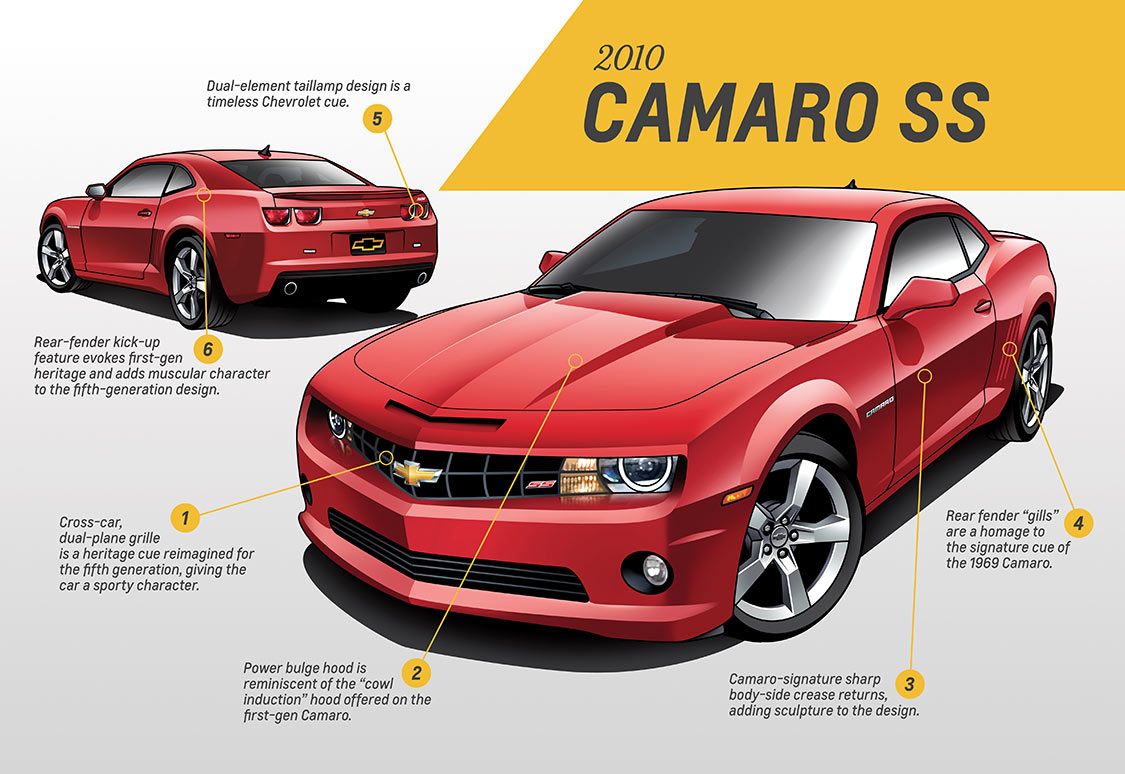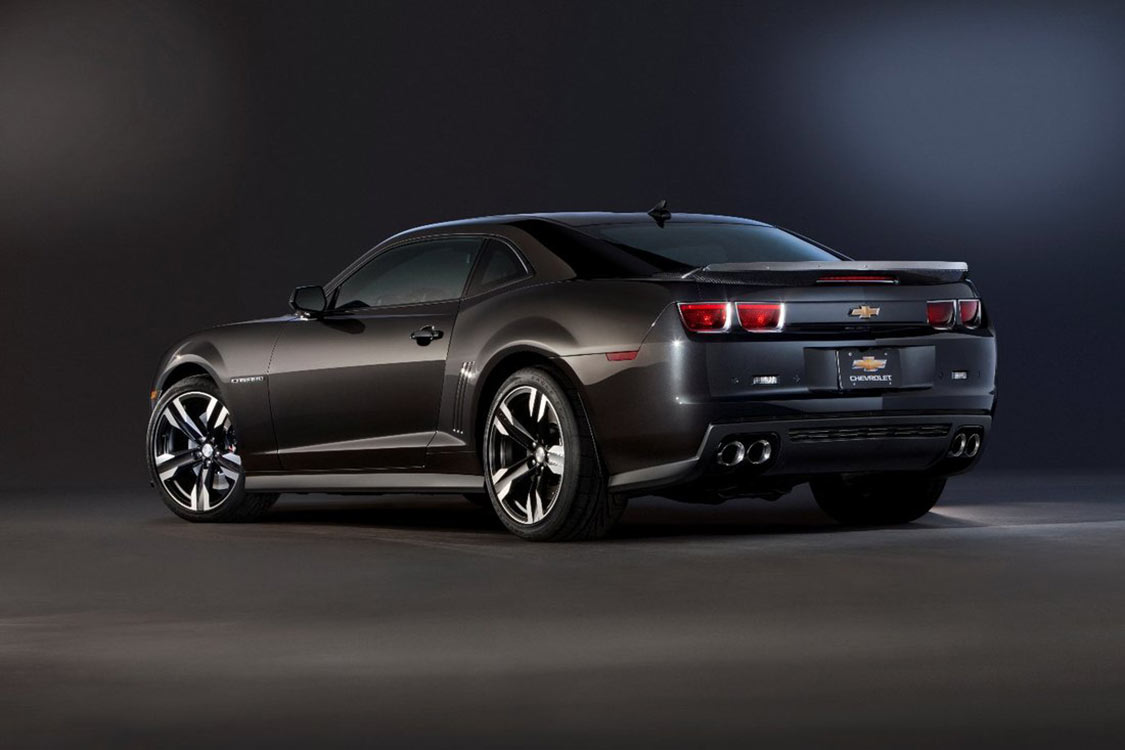Monte Doran Chevrolet Communications January 22, 2023 All Feature Vehicles
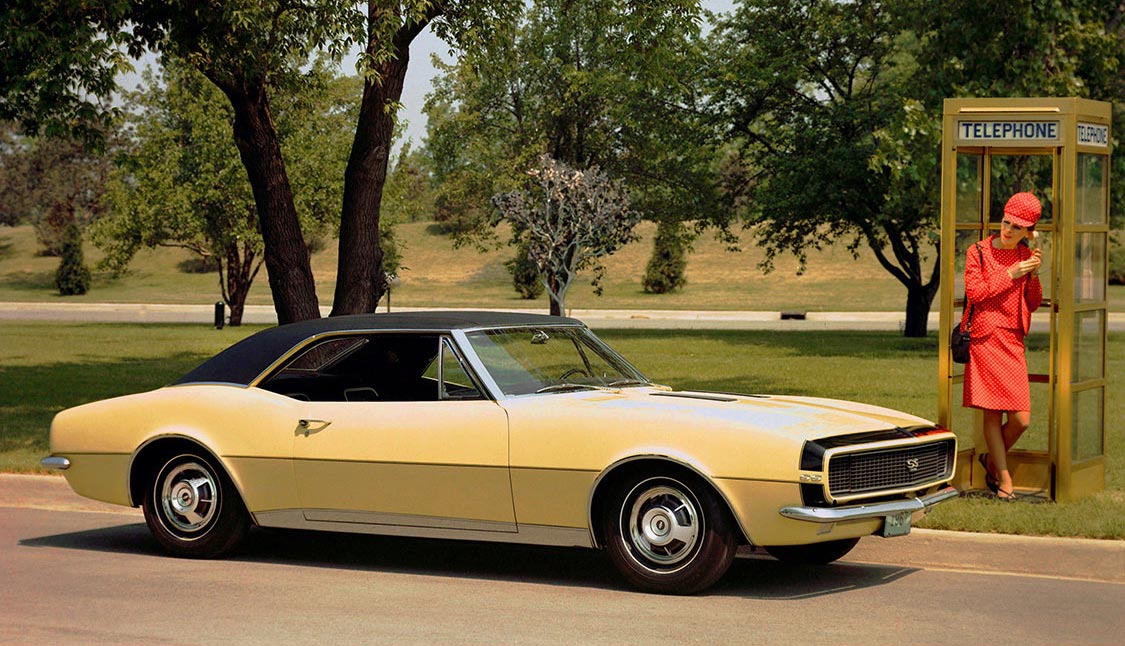
On June 21, 1966, two-hundred Automotive Journalists were informed of an important Chevrolet press conference to be held on the 28th. The rumors were that Chevy was working on a competitor to the wildly successful Ford Mustang.
Foutreen cities were hooked up by telephone and it was announced that Chevrolet’s new pony car would be called Camaro. Chevrolet General Manager Pete Estes claimed that the name suggested friendship, as a car should be to its owner. The story goes that 2 GM executives found the name in a book about French slang, saying that “Camaro” means friend or pal. In reality the word for that is Camarade, Camaro is not a recognized word in French. It’s said that a Chevrolet representative claimed that the Camaro was “a small vicious animal that eats Mustangs”.
The Camaro, and its cousin the Pontiac Firebird, were both unveiled on September 12. The Camaro came in a bewildering array of variants with RS, SS, and Z/28 trim levels. The Z28 was the most-powerful model with a 4.9 liter V8.
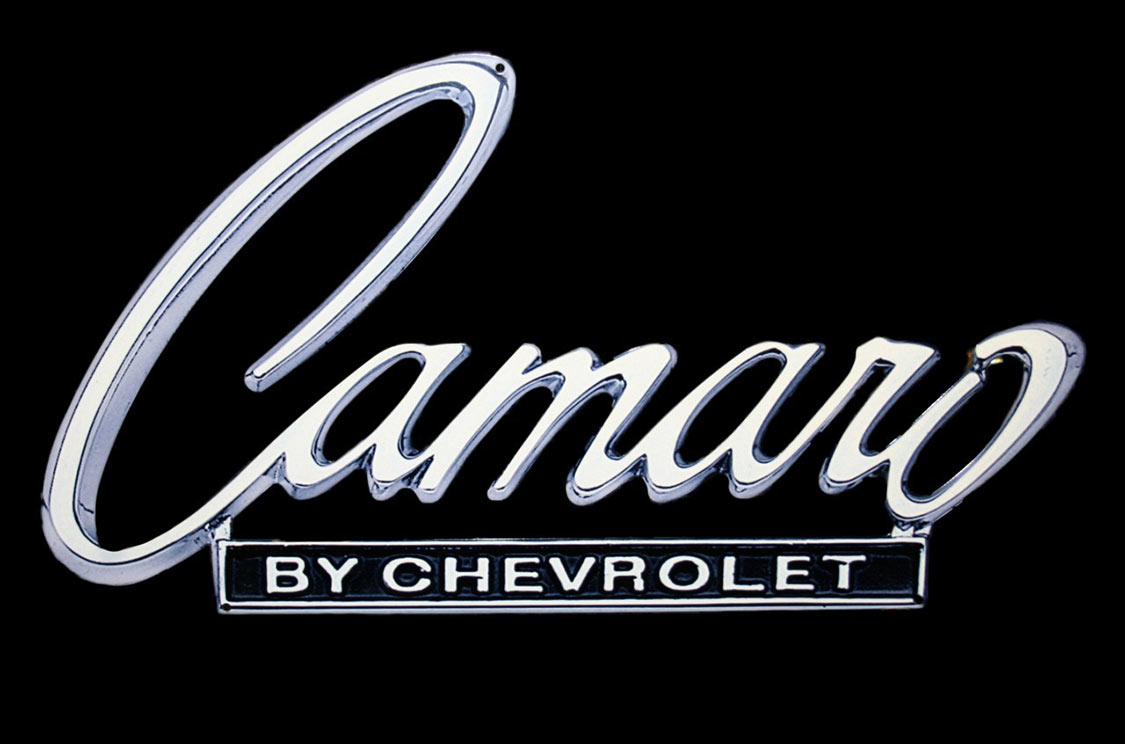
Sales for 1967 were disappointing, with only 220,000 purchased, compared to 472,000 Mustangs. But the gap would close, not because the Camaro would rise, but because of plunging Mustang sales, by 1969, 243,000 Camaros were sold against 299,000 Mustangs.
Since its 1967 introduction, the Camaro’s engine output has ranged from a low of 88 horsepower to a peak of 580, as the pony car rode the highs of the muscle car era in the late-1960s and the lows of the oil embargo-influenced 1970s to the emergence of modern technologies in the 1980s and the unprecedented power and efficiency offered today.
“From the day it was introduced, the Camaro has been part of American culture and a reflection of the state of the American performance industry,” said Dean Guard, General Motors executive director global gasoline engine engineering, whose first car was a 1982 Camaro with a 5.0L V-8.
“What has never changed was the Camaro’s fun, attainable performance for a broad spectrum of customers, and the personal connection it inspired with generations of owners.”
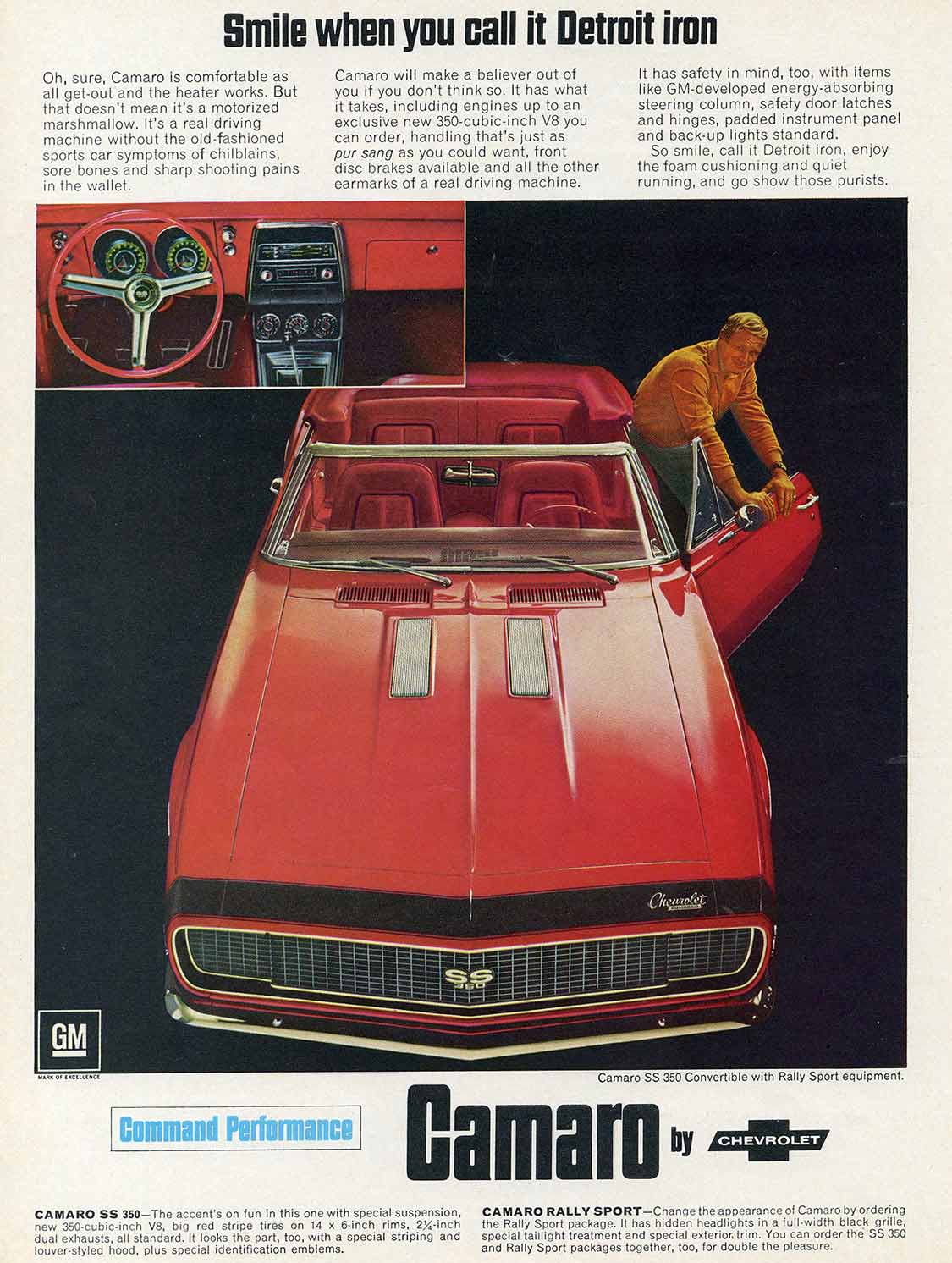
In the 48 years since Camaro’s arrival, the engine families and the technologies supporting them have evolved dramatically, from the carbureted inline-six base engines and brawny range-topping big-block V-8s in the early years, to the sophisticated V-6 and V-8 engines of today that use advanced technologies to deliver a balance of power and efficiency undreamt of in 1967.
Technologies including direct injection and continuously variable valve timing in the 2015 Camaro’s base 3.6L V-6 help generate 323 horsepower. That’s more than any Camaro V-8 engine offered between 1971 and 2000 – and it enables up to 30 mpg on the highway.
As the Camaro closes out the final year of its fifth generation, Chevrolet has compiled a historic overview of the engines that have contributed to its icon status for enthusiasts around the globe.
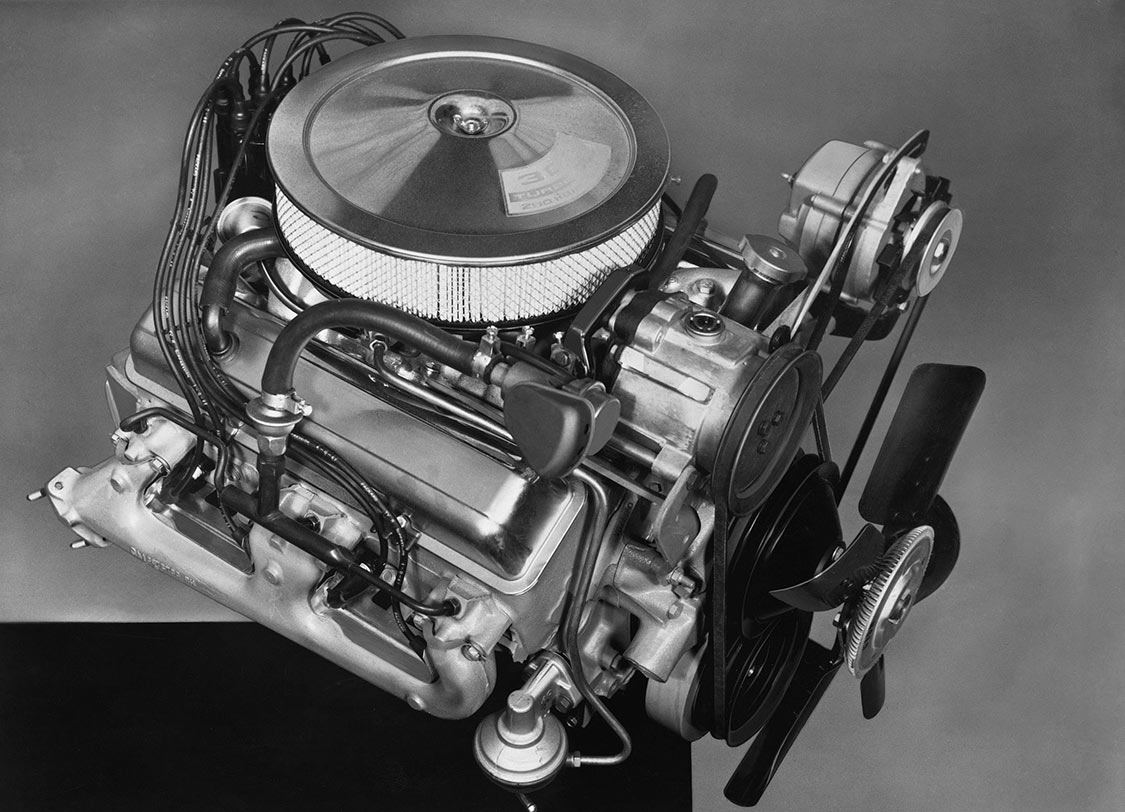
The Camaro debuted in the burgeoning personal coupe market and at the height of the muscle car era. Entry-level models offered two versions of Chevrolet’s stalwart inline-six engine, with a minimum of 140 horsepower and 220 lb-ft of torque.
Higher-performing models were available with a smorgasbord of V-8 engines, ranging from 200 horsepower in the 307-cubic-inch Small Block to the 375-horsepower 396 Big Block. Sixty-nine special-option COPO Camaros were built with 427-cubic-inch engines. Intended for Stock and Super Stock drag racing classes, their respective 425- and 430-horsepower ratings were widely believed to be underestimated.
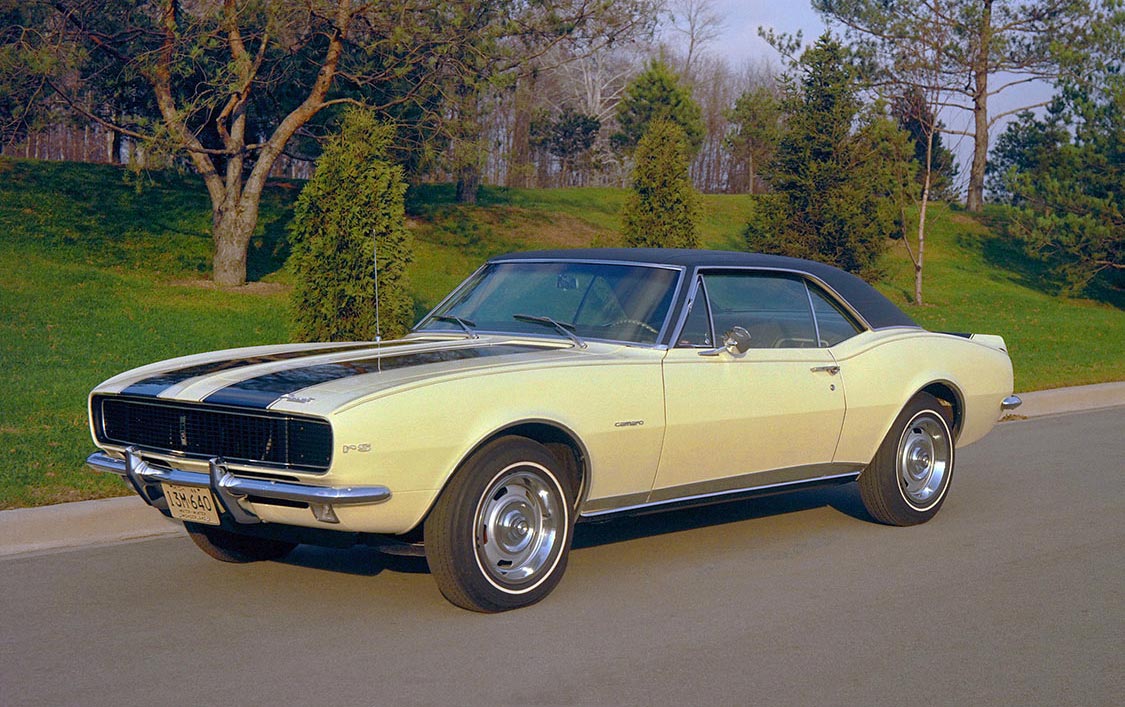
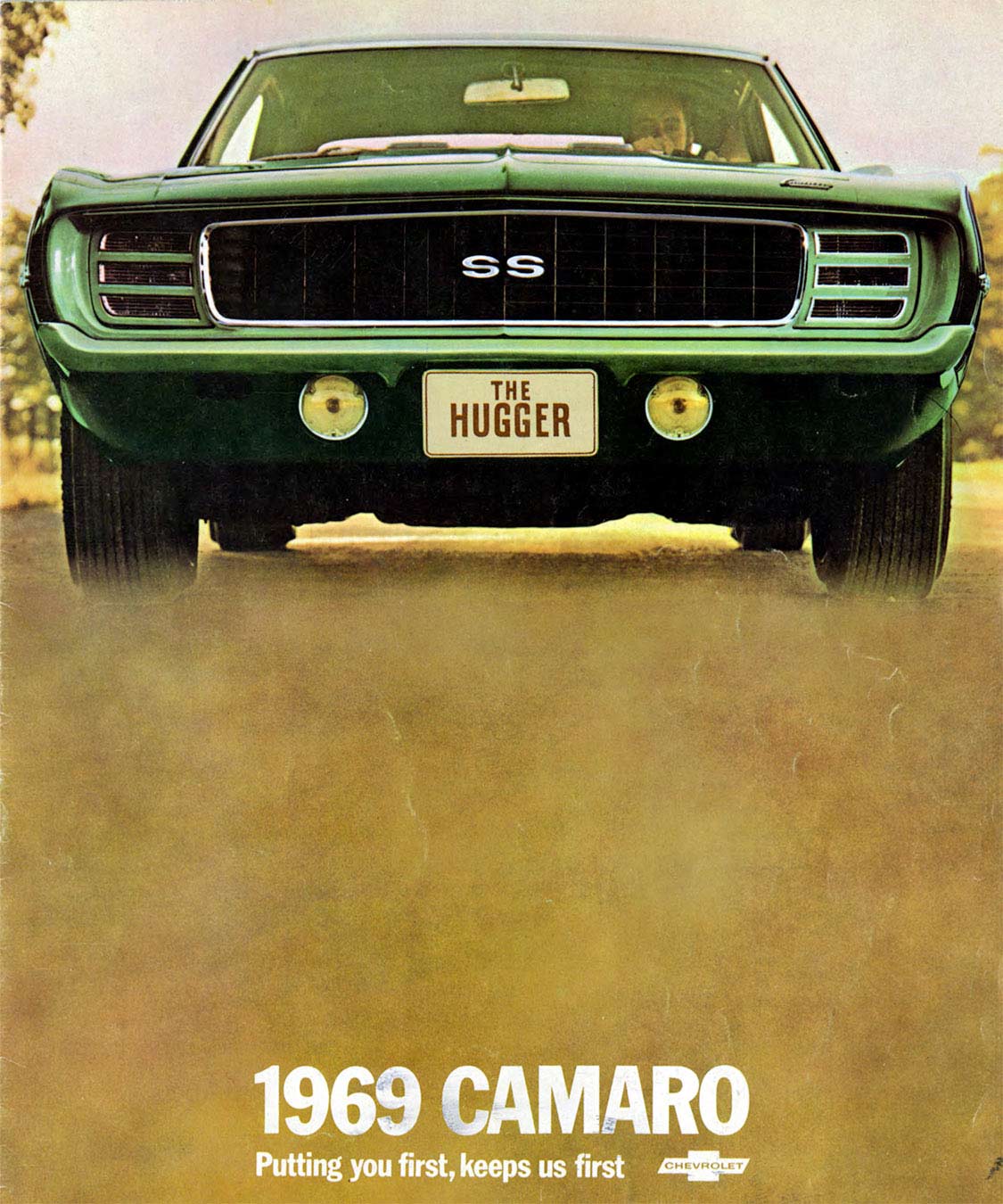
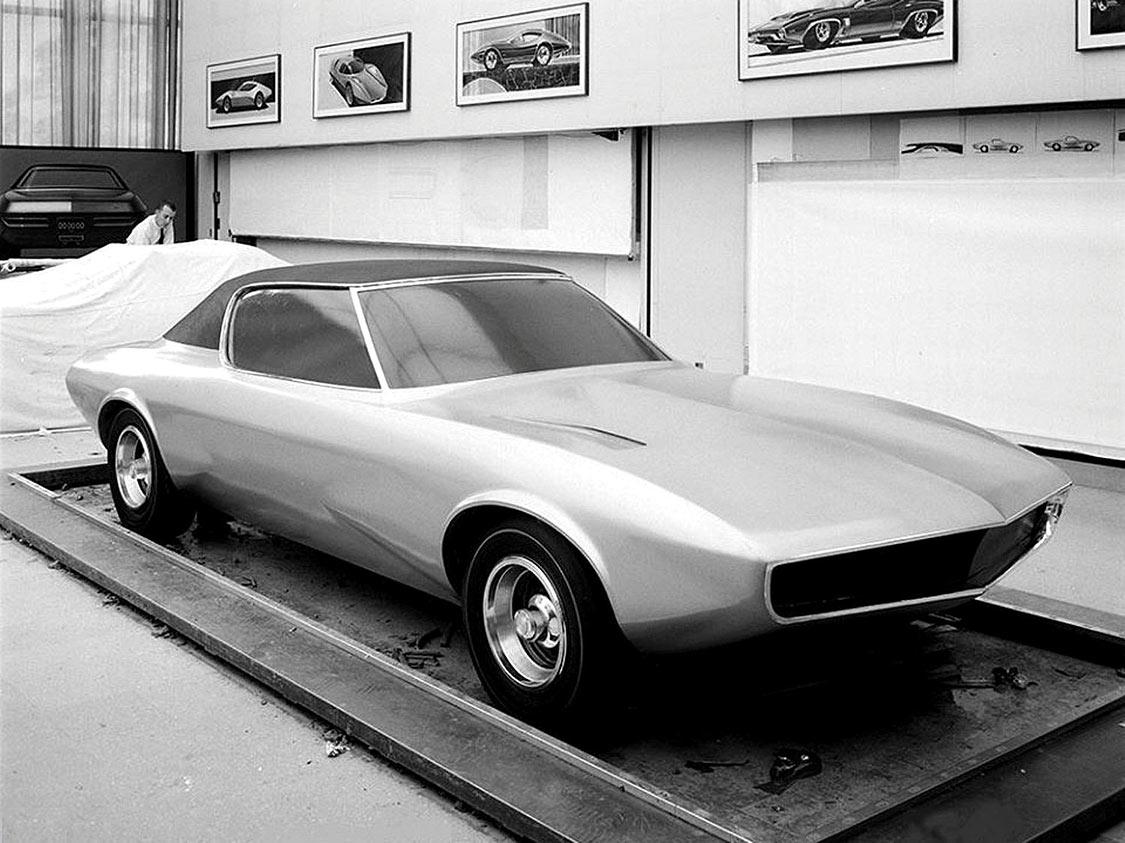
Following the upsurge in Ford Mustang sales, Chevrolet management discovered that their mid-engine sporty model, the Corvair, might not be as successful as the Mustang. With that realization, Chevrolet attempted to sell the Camaro to compete as the same front engine, traditional rear drive configuration as the Chevy II Nova and Mustang. Additionally, the car was created to incorporate a wide range of power plants into the engine bay to satisfy hungry buyers.
The original Chevrolet prototype had some of the lines that made it on the final version that would roll off the assembly line starting in 1967 but you can also recognize other visual influences, including European.
Prototypes are many times more sculpture than vehicle, as they engineers test air flow, stance and manufacturing processes.
You may notice this version has no door handles, or doors, or a functioning hood.
Higher-performing models were available with a smorgasbord of V-8 engines…
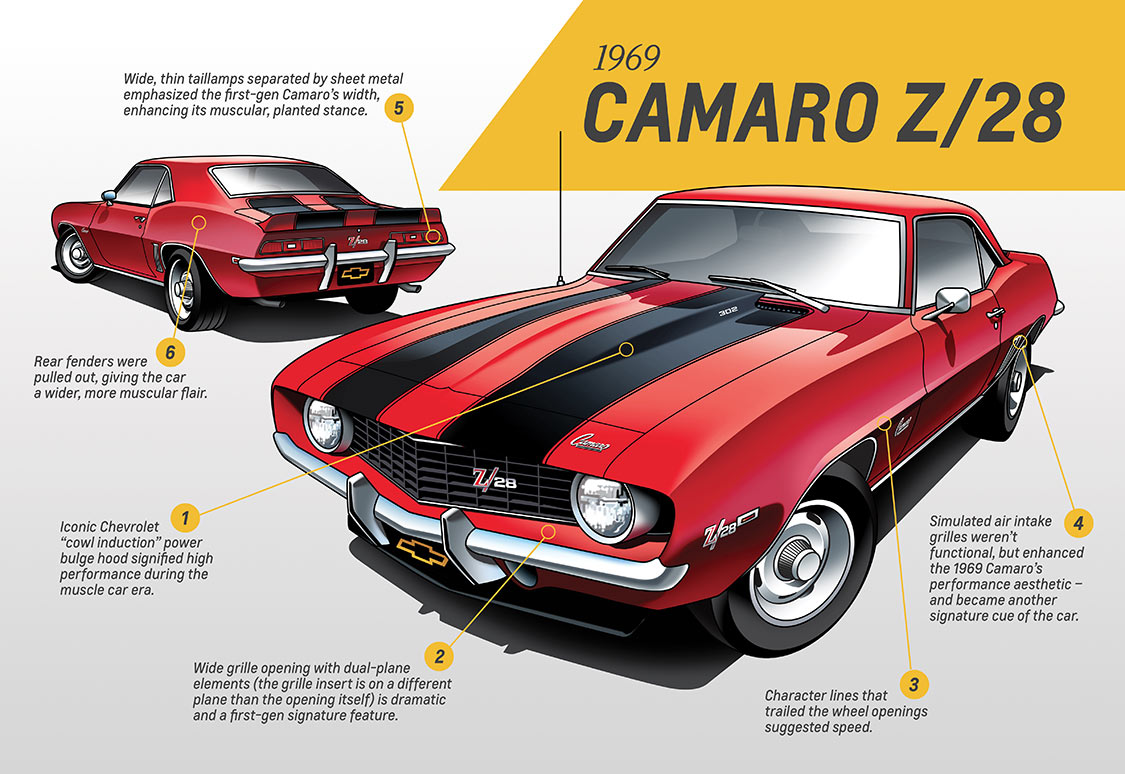
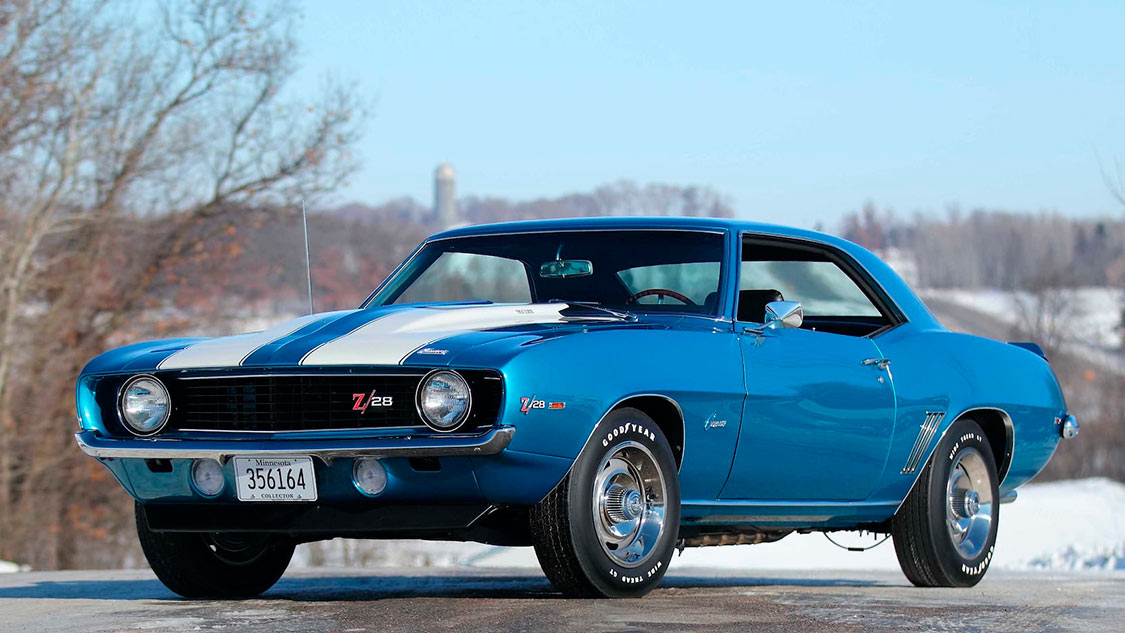
From tame to insane:
The Camaro chameleon lends itself to every kind of driving style, from mild grocery-getter to the performance transformations of Funnycar ground pounders, and track tanglers like the Penske Racing race winner shown here.
With more than 50 years of heritage, the Camaro has seen many podiums and many parking lots.
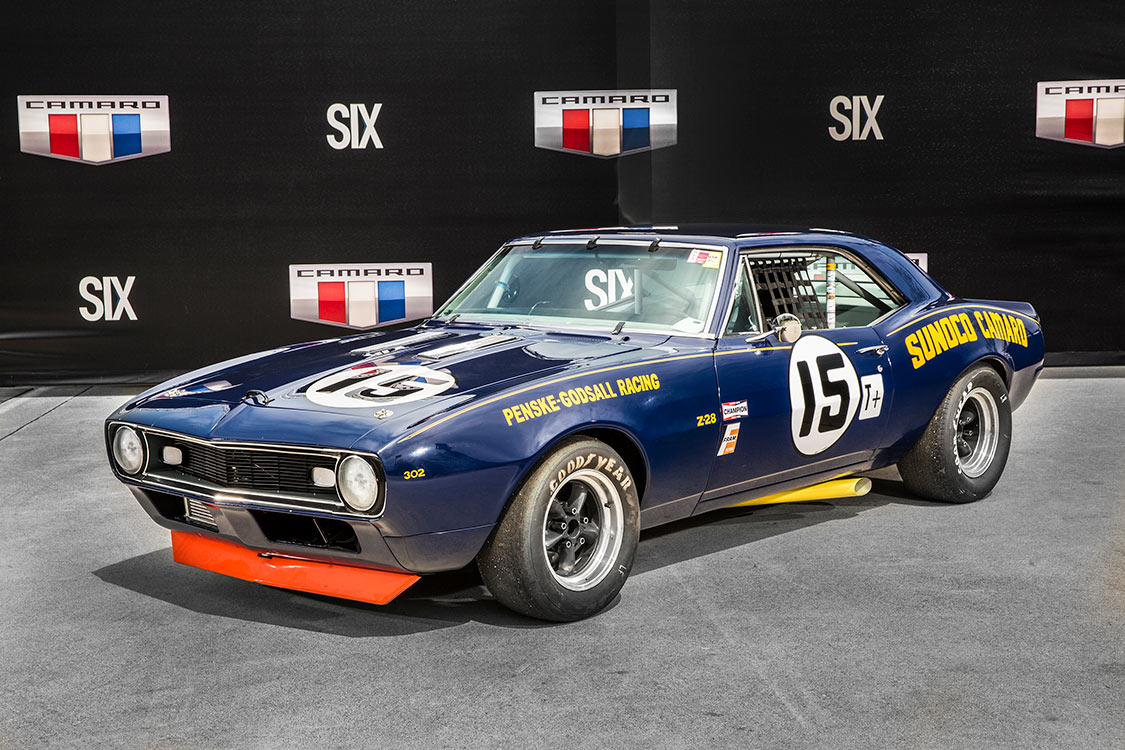
Signs of success:
When Mattel casts a Hot Wheel of your design you are sure to garner respect.
The Camaro has had every one of its Generations replicated in untold numbers of die-cast, plastic, wood, and who knows what other materials to honor the fan-favorite and contribute to its immortal status.
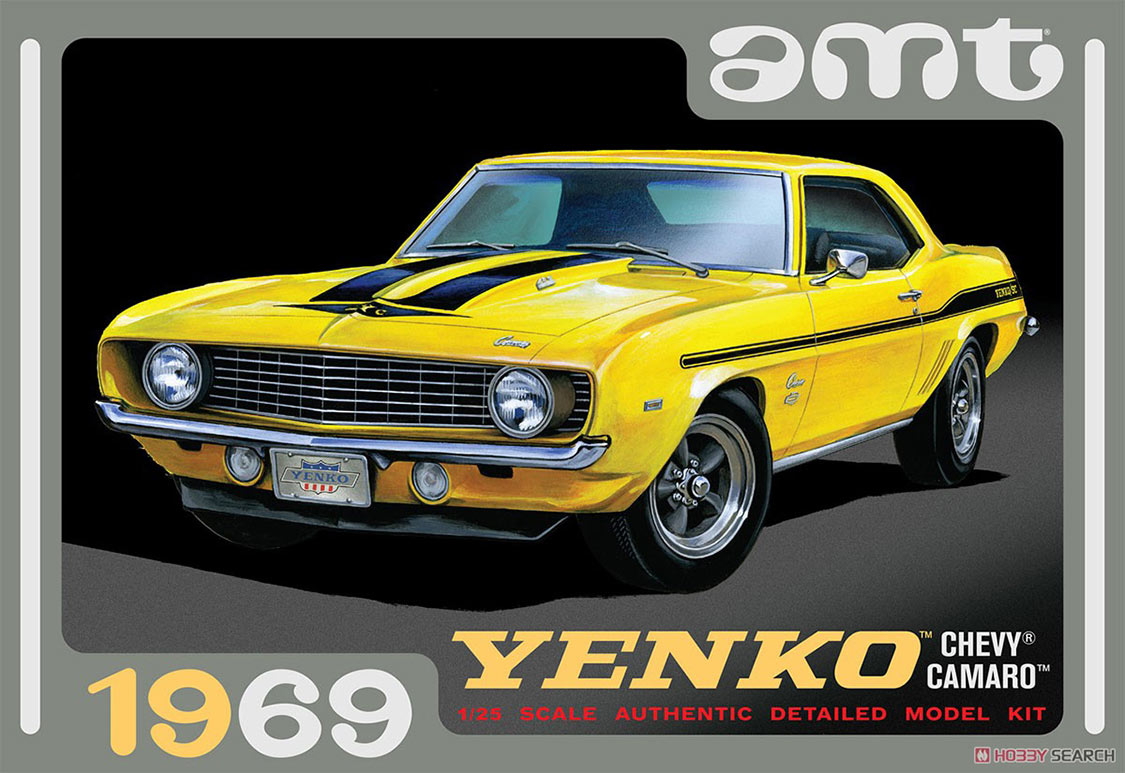
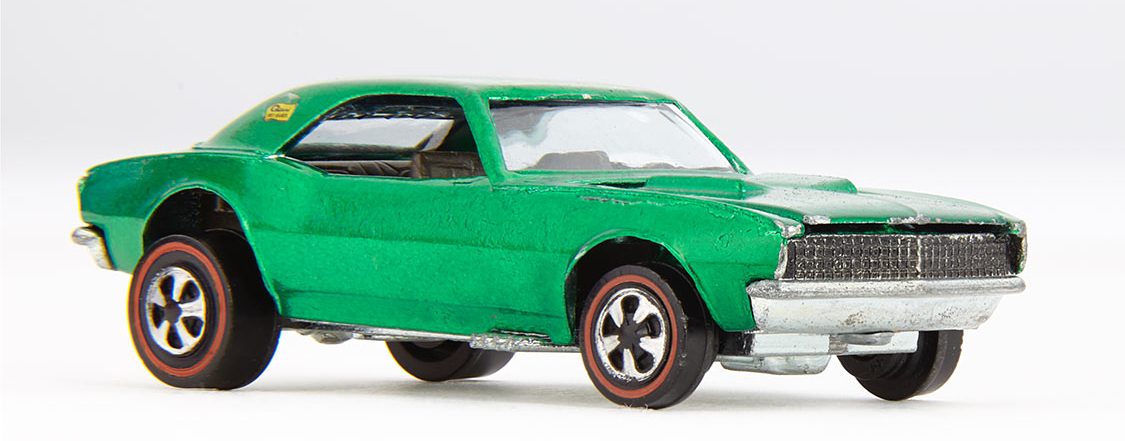
The Camaro’s second generation occurred during a tumultuous time in the auto industry as regulatory changes, including the change to unleaded fuel for lower emissions and an increased focus on fuel economy in response to Arab oil embargoes that led to lines at gasoline stations. As engineers worked to meet these new requirements, the industry saw dramatic reductions in engine compression, horsepower and torque.
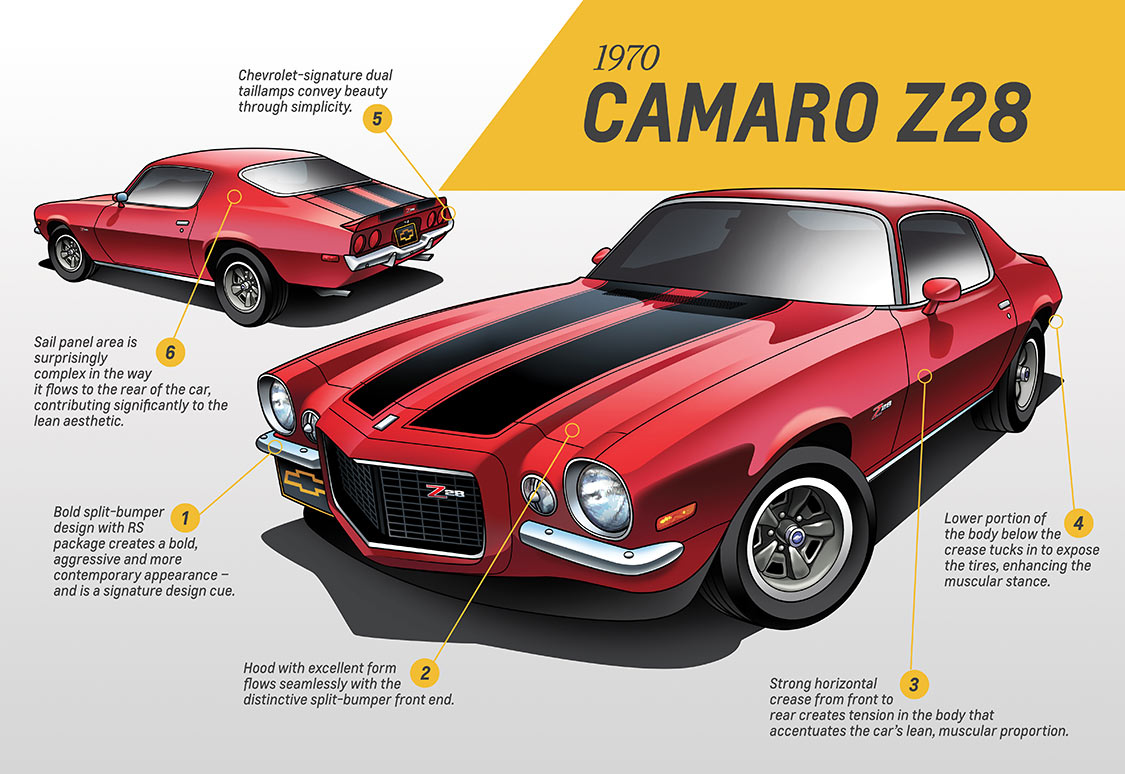
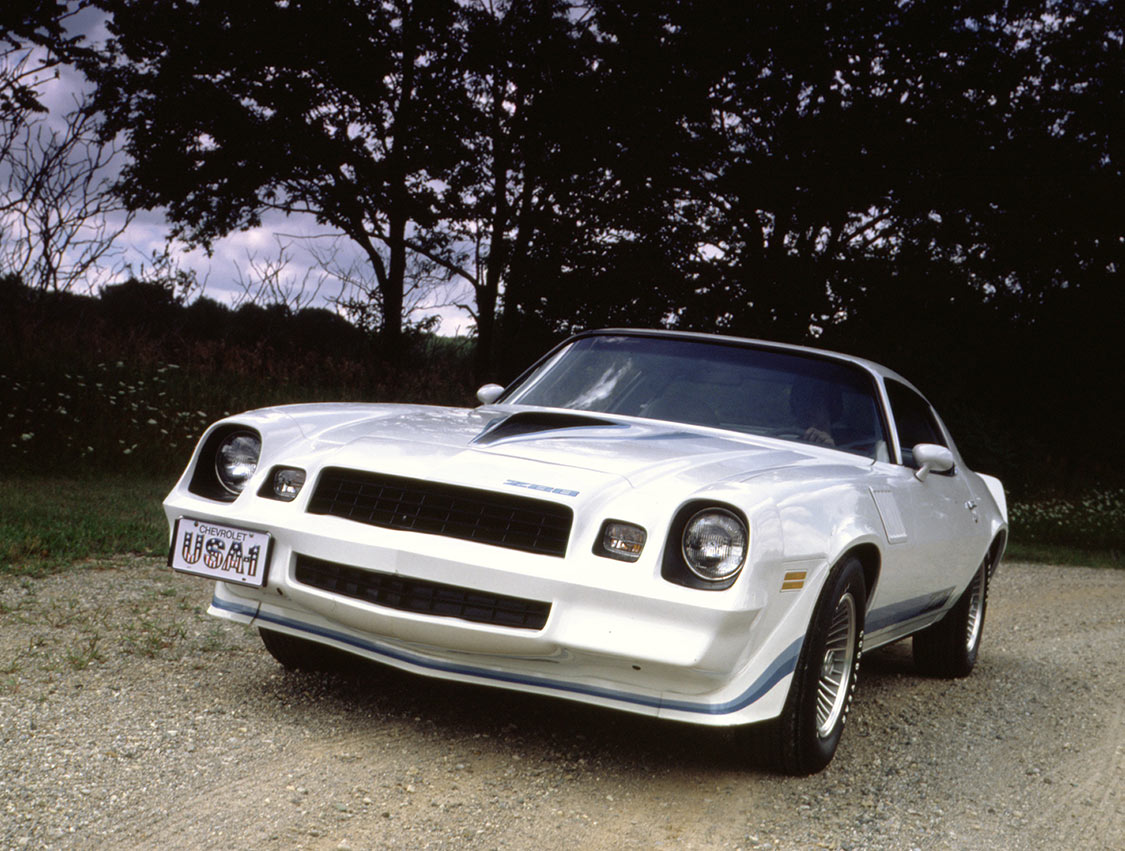
Camaro output peaked in 1970, with 375 hp and 415 lb-ft, but by 1975 the most powerful V-8 model offered only 155 hp. The Camaro wouldn’t see more than 200 horsepower again until the mid-1980s.
The Big Block engine family was dropped after 1972, while the venerable inline-six engine was replaced by more modern V-6 designs in 1980. The Small Block was the only engine family to last through the entire second generation, ranging from a high of 360 horsepower for the 1970 Z28 to 115 horsepower by the mid- and late-1970s.
… a tumultuous time in the auto industry as regulatory changes, including the change to unleaded fuel …
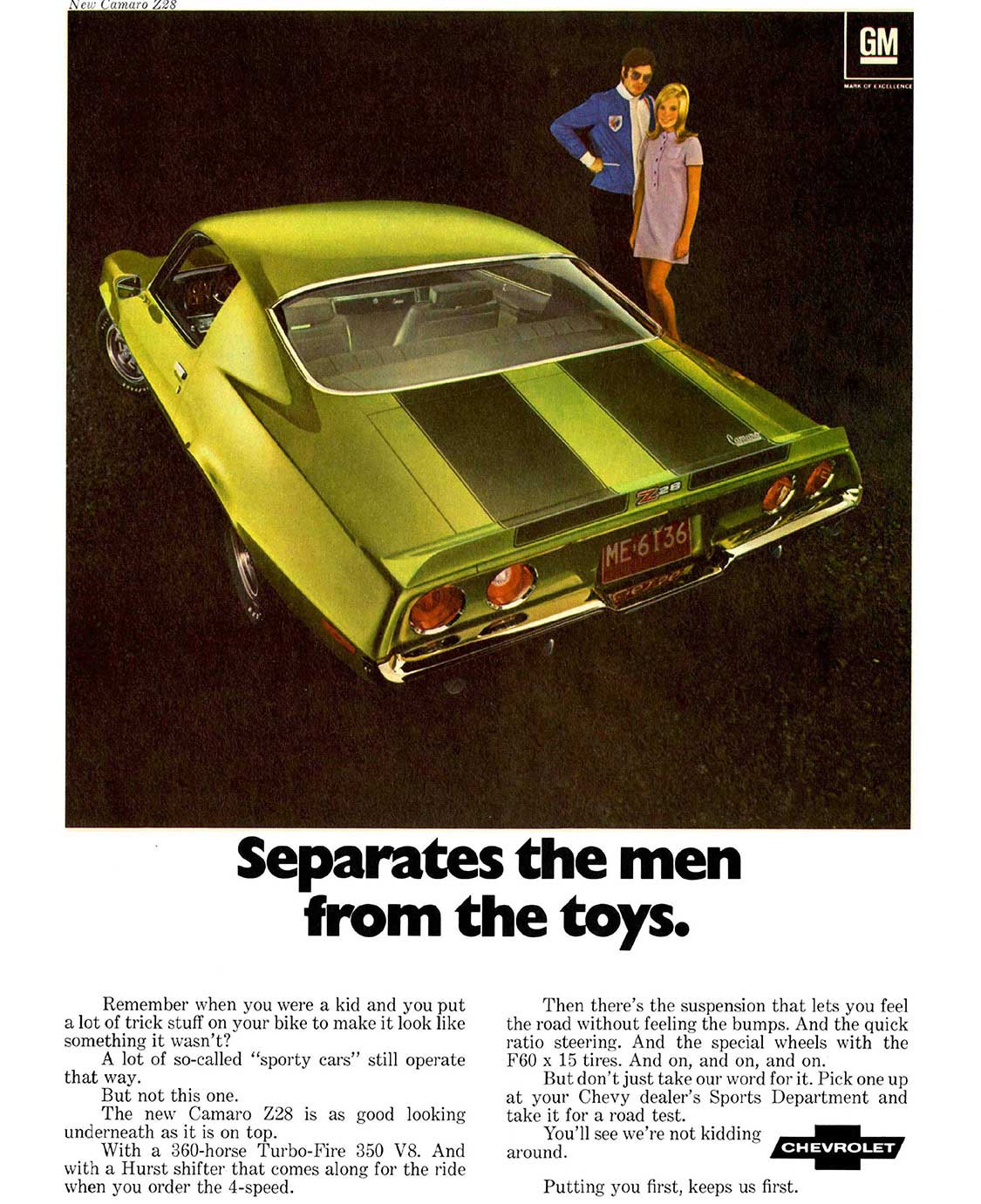
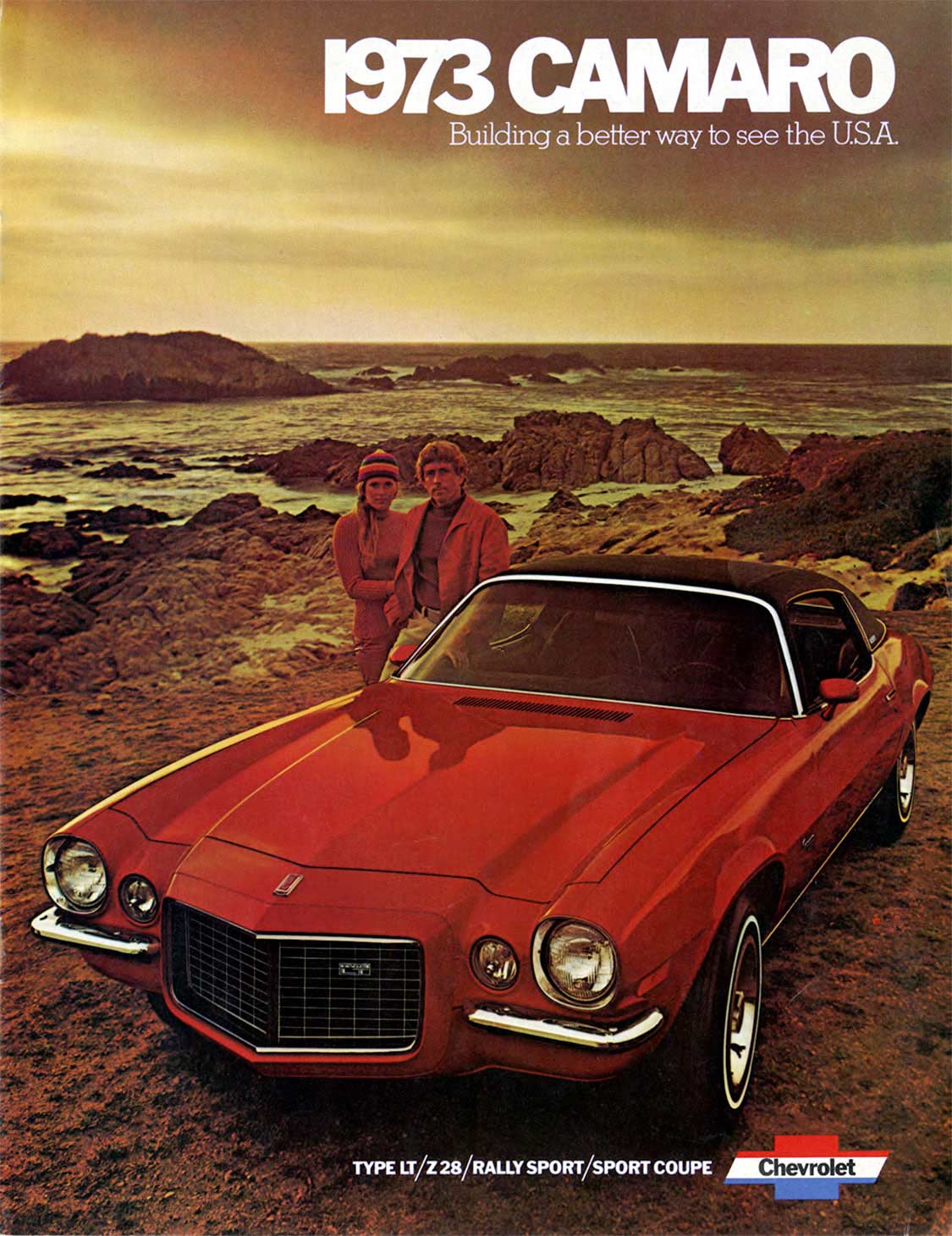
The third generation of the Camaro saw the introduction of new technologies, each progressively improving output and performance.
For the first time, the Camaro was offered with a four-cylinder engine. Between 1982 and 1986, the 2.5L inline-4 produced 88 to 92 horsepower, depending on whether it was fitted with a carburetor or a new electronically controlled fuel injection system.
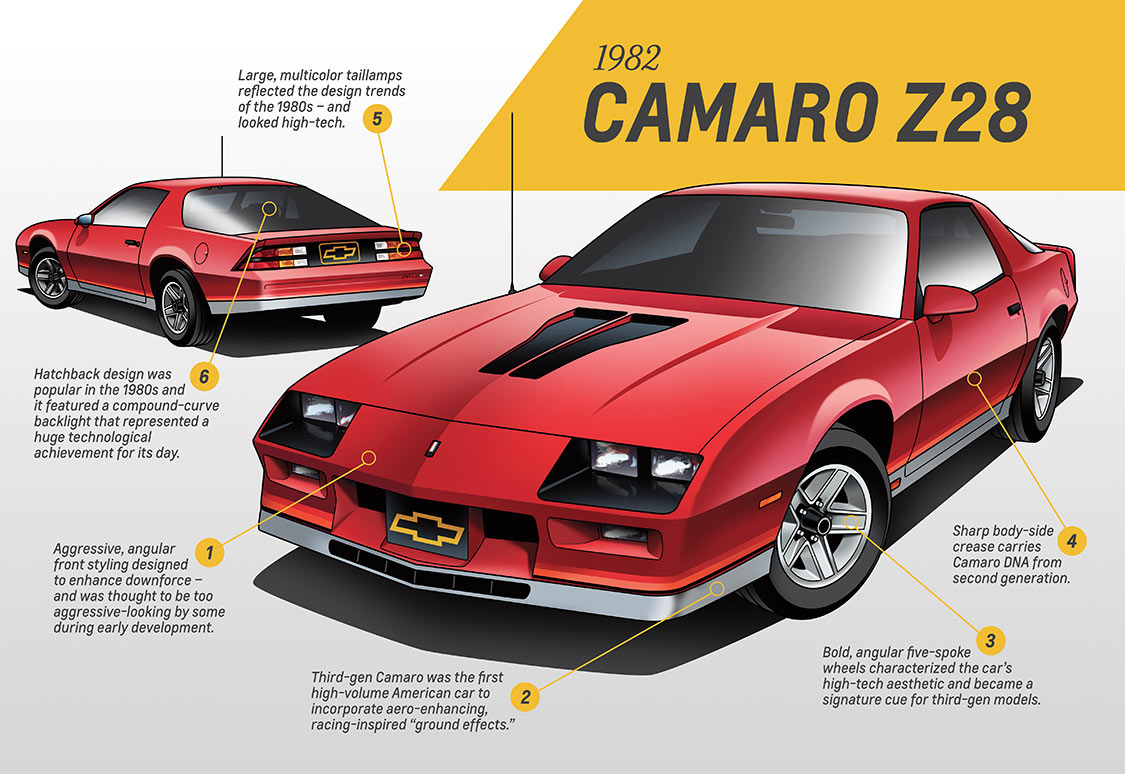
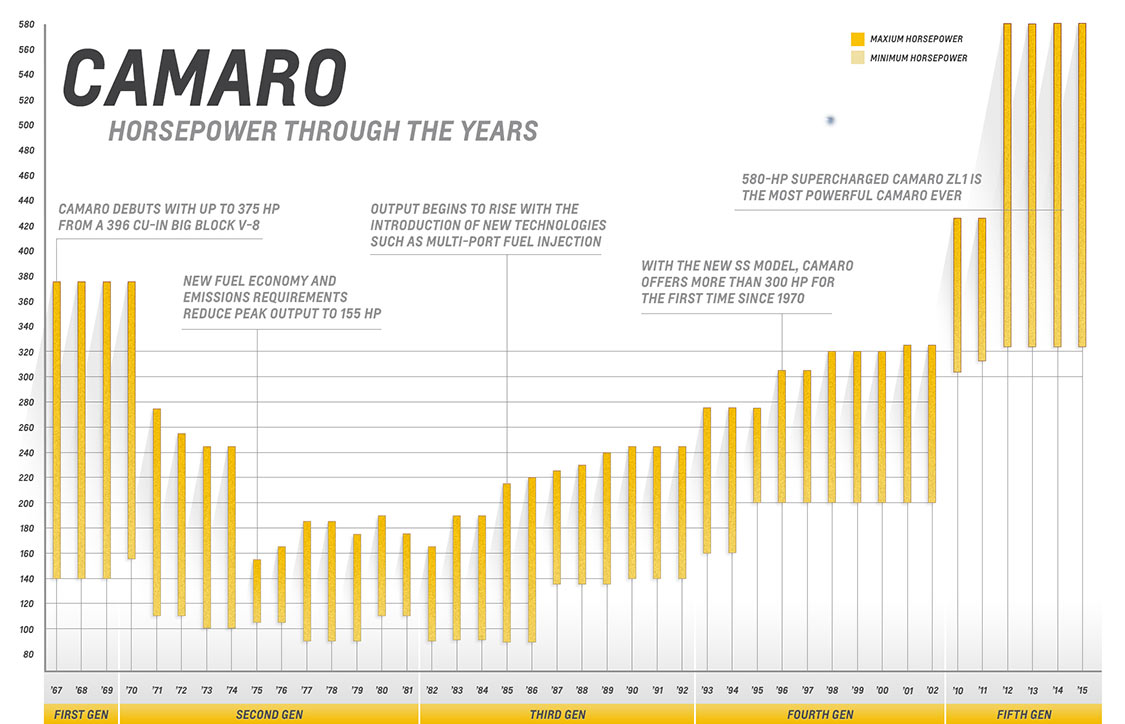
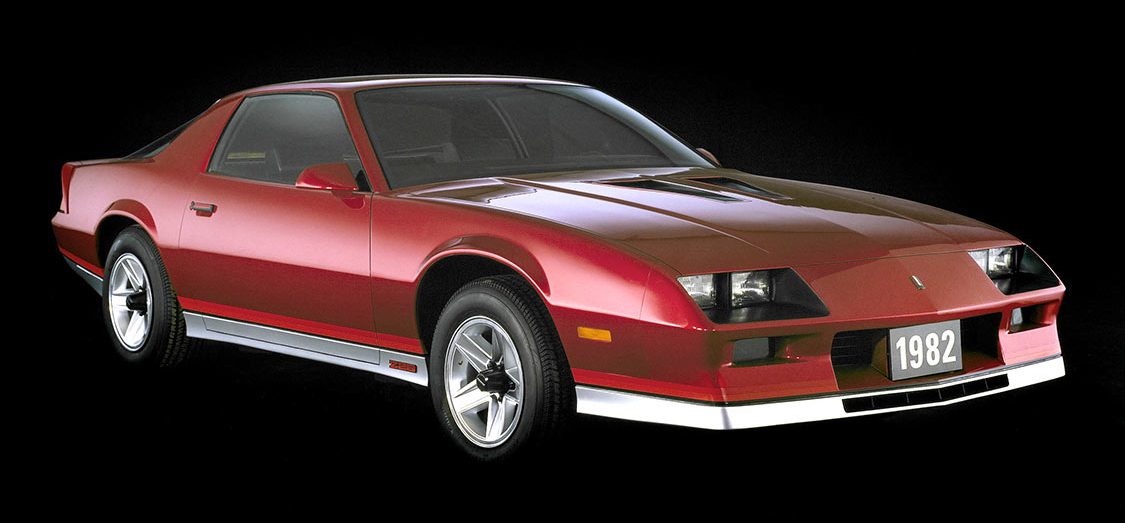
Fuel injection also spread to the V-6 and V-8 engine families, enabling engineers to balance efficiency with greater performance. Early editions used Throttle Body Injection (TBI) and, later, the highest-performing models of the 305 and 350 engines featured Tuned Port Injection (TPI).
In 1990, the Camaro 350 TPI engine peaked at 245 hp and 345 lb-ft of torque – making it the most potent Camaro since 1973.
In 1990, the Camaro 350 TPI engine peaked at 245 hp and 345 lb-ft of torque – making it the most potent Camaro since 1973
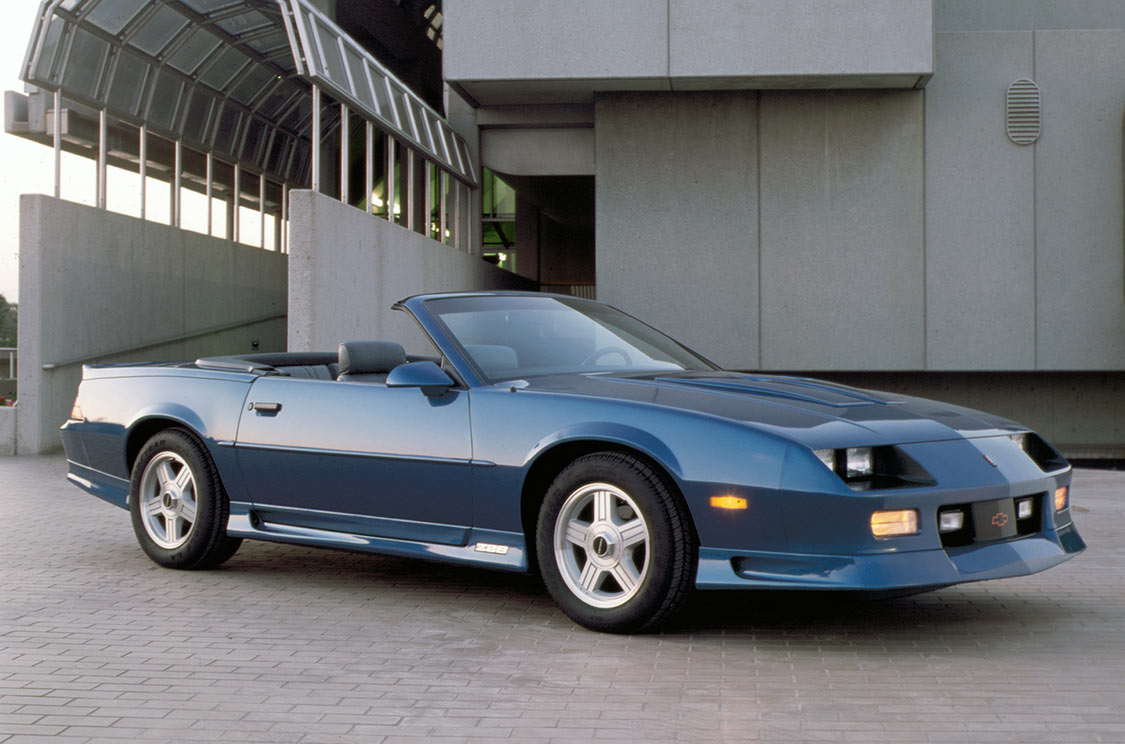
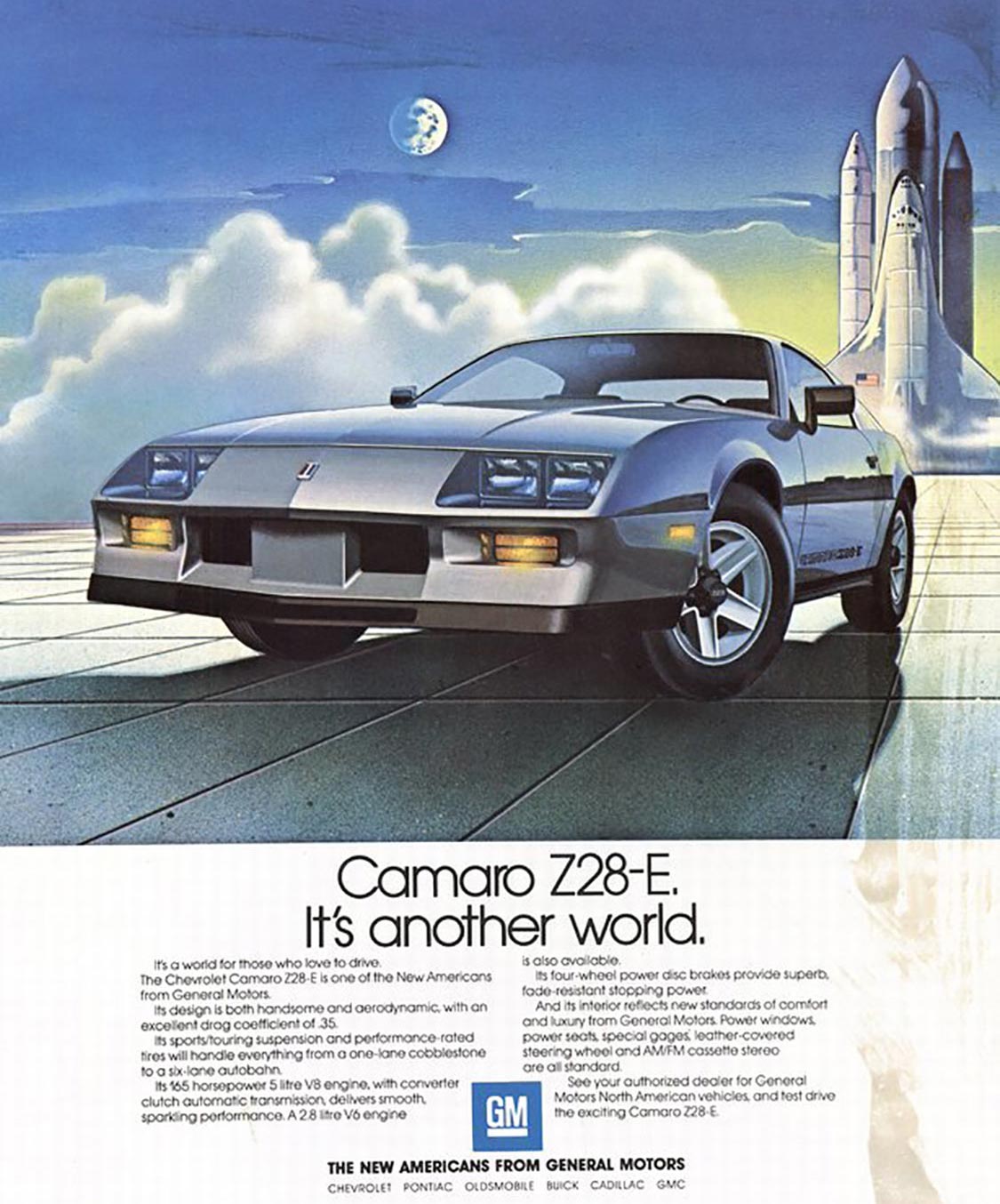
A streamlined powertrain lineup greeted the Camaro’s fourth generation, with a single V-6 and Small Block V-8 offered in each model year.
The base engine evolved from a 160-horsepower version of the 3.4L V-6 to a 200-horsepower version of the renowned 3.8L V-6. The lightweight, compact powerhouse offered performance comparable to most of the Third Generation Camaro V-8 models.
The Small Block V-8 was available with up to 305 horsepower in the 1996-97 Camaro SS.
An all-new, Gen III “LS1” Small Block V-8 was available in the 1998 Camaro, delivering 305 hp and 335 lb-ft of torque, making the Camaro SS and Z28 models worthy rivals for anything from the muscle car era.
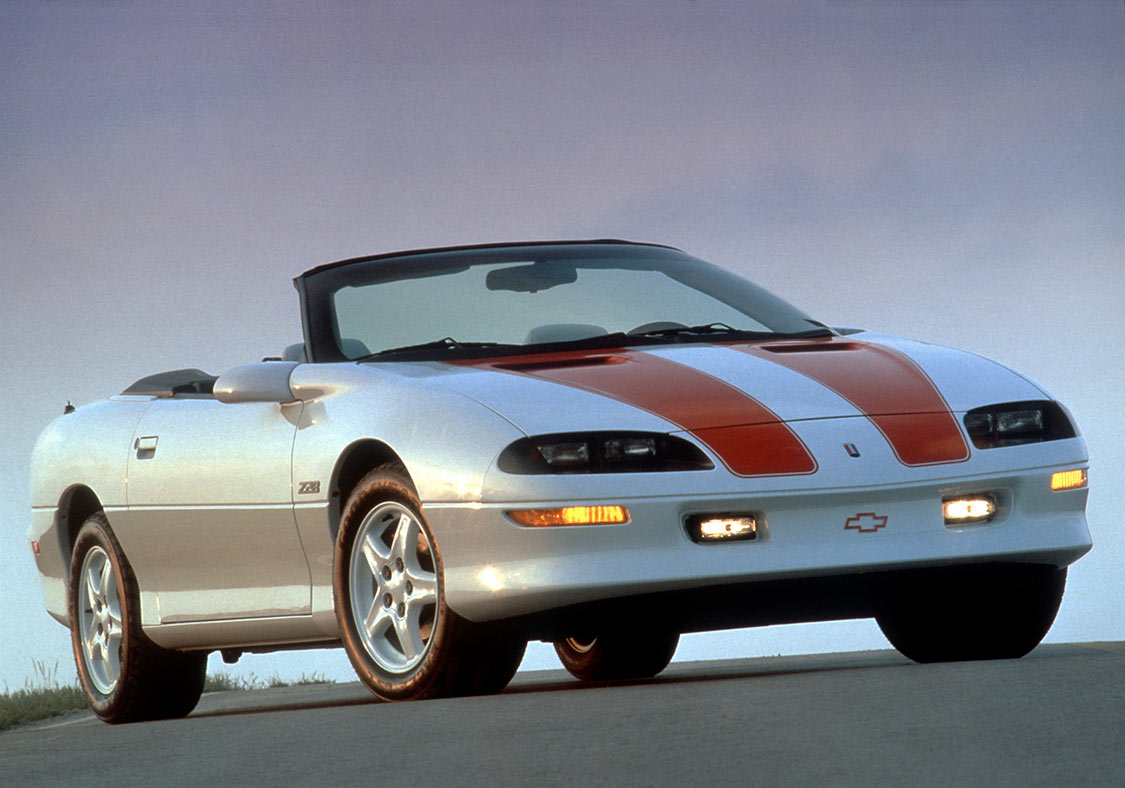
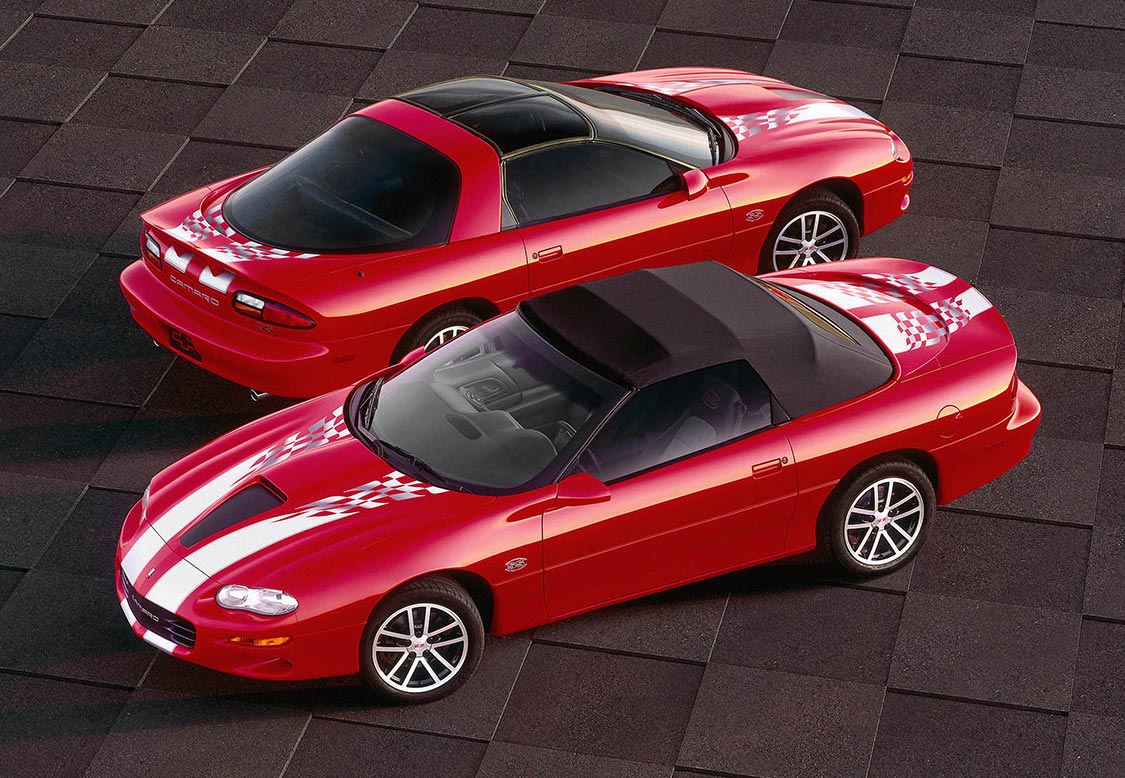

The fourth-generation Camaro was offered in a difficult period in automotive manufacturing, even as the evolution of EPA-compliant engines improved dramatically, the declining sales in the sports car market eventually came to a close as the 2002 model year of the renowned Camaro was put on “hiatus”.
The executives at GM predicted that the sport coupe market would eventually return, and the Camaro needed to be prepared to meet that call to return to the street and strip.
On August 27th 2002, the assembly plant in St. Therese, Canada produced the very last Camaro, a red convertible that went to be displayed at the GM Heritage Center’s collection. The plant officially closed forever on Thursday, August 29, 2002.
… making the Camaro SS and Z28 models worthy rivals for anything from the muscle car era.
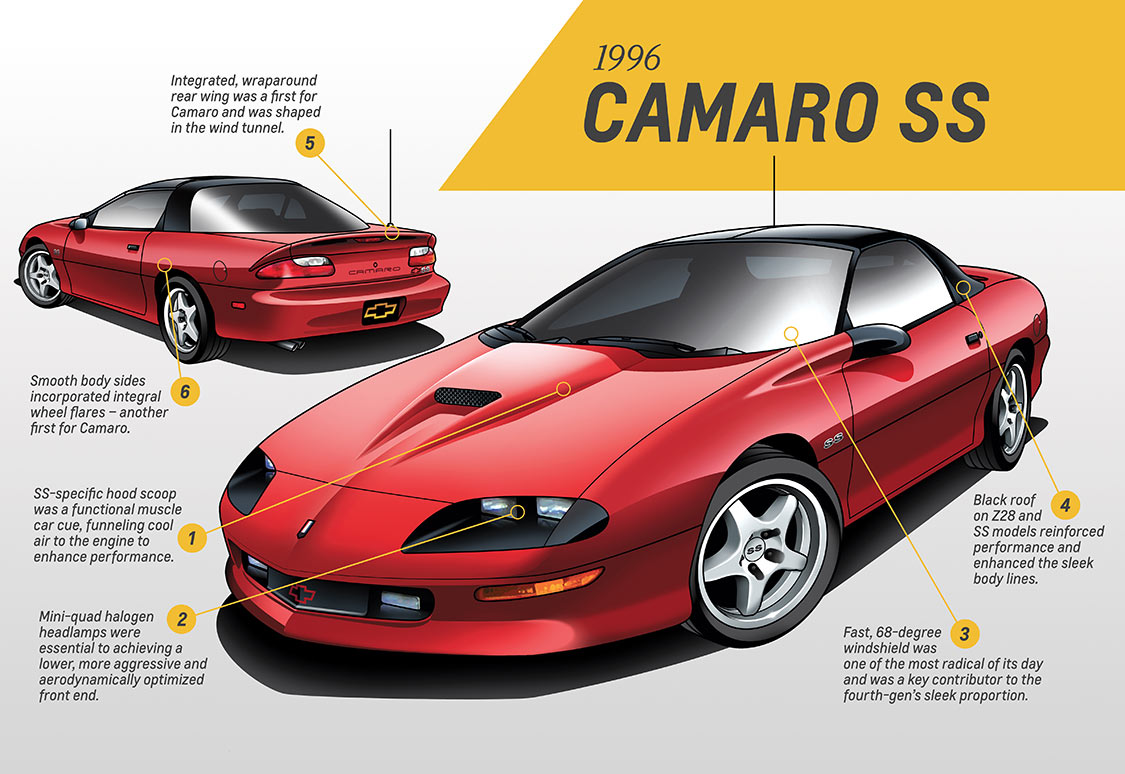
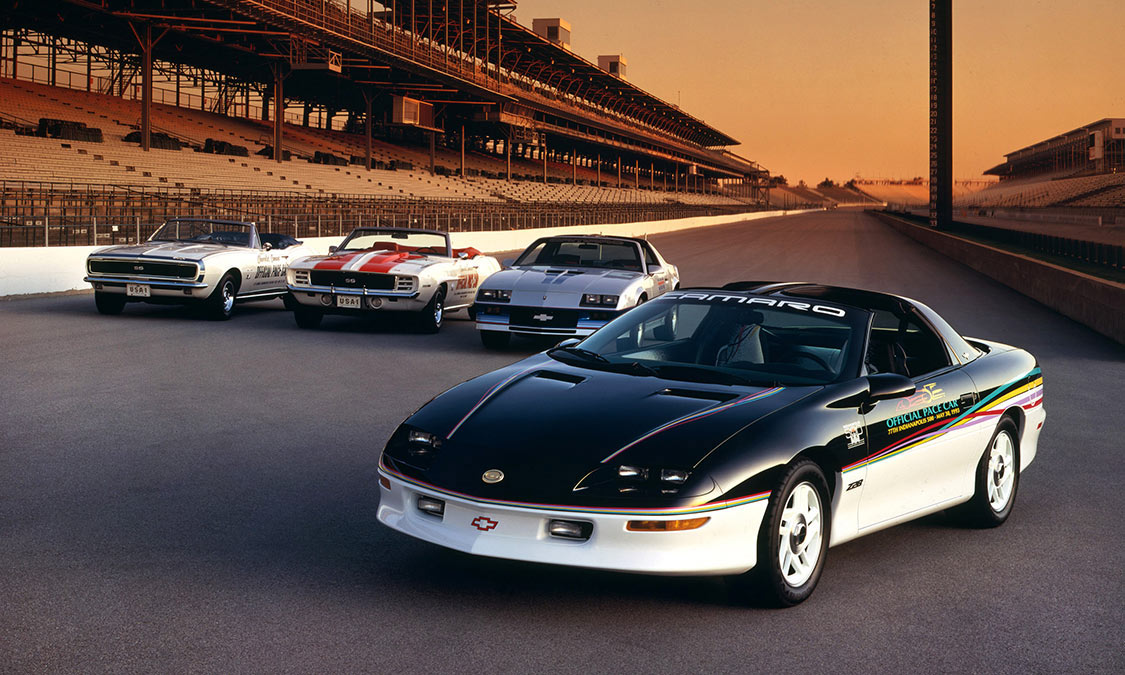
After an eight-year hiatus, the Camaro roared back with more standard horsepower than ever – more than 300 horsepower from a sophisticated DOHC V-6. By 2012, the Camaro V-6 had increased to 323 hp, and 278 lb-ft of torque, while enabling up to 30 guilt-free miles per gallon on the highway.
The Camaro’s new, 6.2L Gen IV Small Block V-8 was rated at 426 horsepower in SS models with the manual transmission – more than any regular-production Small Block or Big Block engine from muscle car era and rivaling the advertised output of the special-order COPO 427 engines from 1969.
The Camaro ZL1’s introduction in 2012 reset the bar for horsepower and torque, delivering a staggering 580 horsepower and 556 lb-ft from a supercharged version of the 6.2L Gen III Small Block. It remains the most powerful production engine in Camaro history.
The Camaro’s new, 6.2L Gen IV Small Block V-8 was rated at 426 horsepower in SS models with the manual transmission
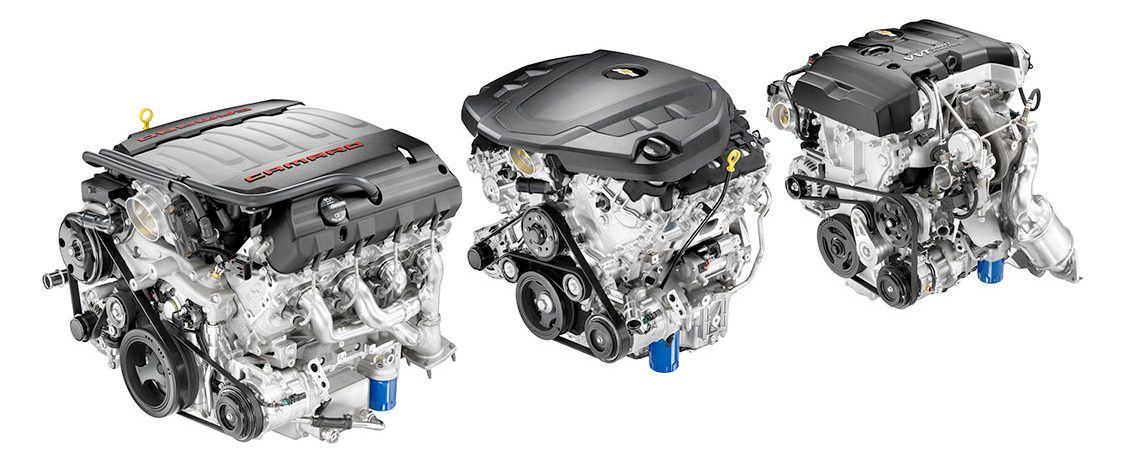
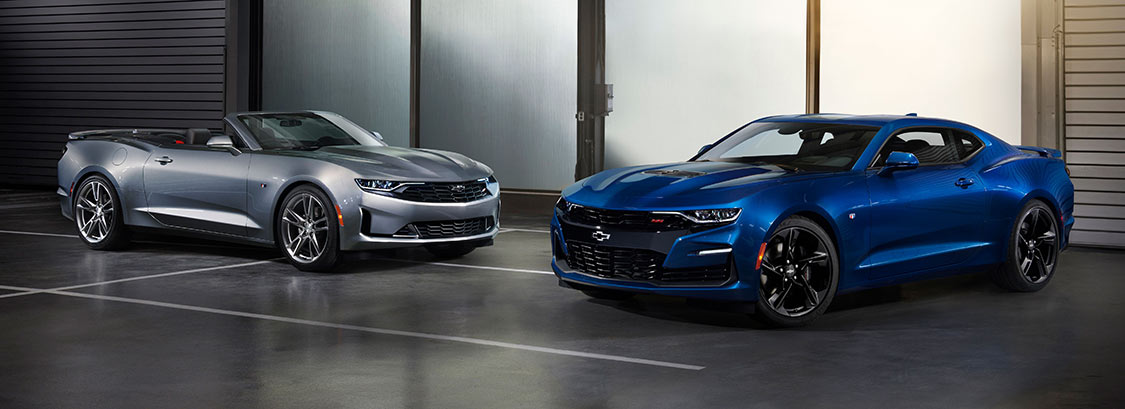
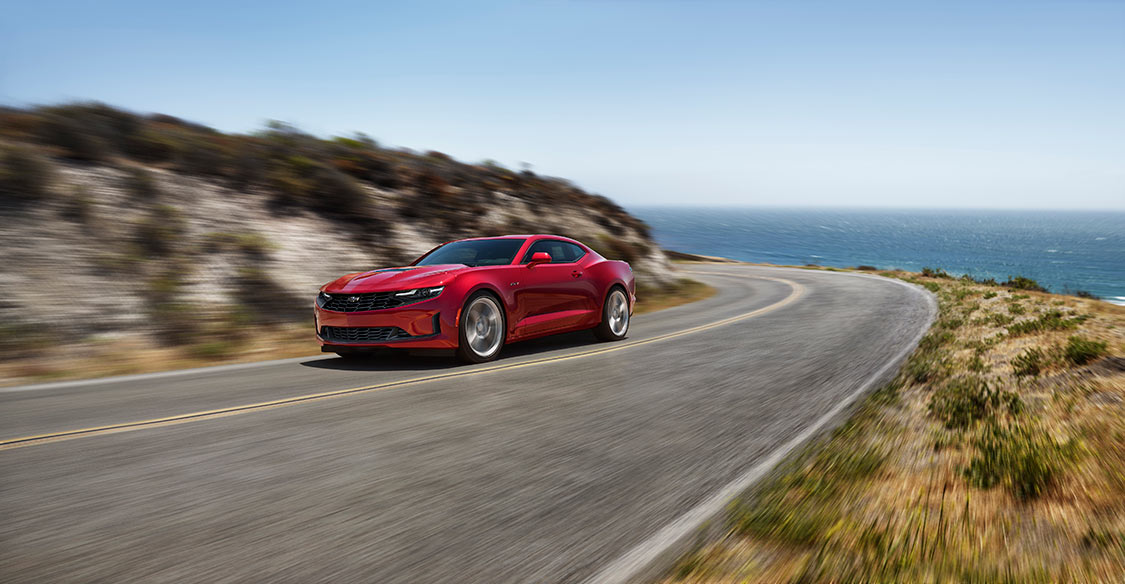
In 2014, the Camaro Z/28 delivered the first factory-installed 427-cubic-inch engine since the legendary COPO models. The naturally aspirated 7.0L engine was rated at 505 horsepower and 481 lb-ft of torque, helping the Camaro Z/28 power its way to Motor Trend’s 2014 Best Driver’s Car award – the first American-brand car to receive it.
On May 16, 2015, Chevrolet introduced the sixth-generation Camaro at Belle Isle Park in Detroit, Michigan. The launch, complete with previous generation Camaros on display, coincided with the vehicle’s 50th birthday. The sixth-generation Camaro is offered in both coupe and convertible models.
For more than 50 years, American sports car enthusiasts have had a love affair with the Camaro coupe and convertible. The sixth-generation model is poised to be one of the greatest convertibles ever, continuing to grow Chevrolet’s sporty car segment market share and sales leadership.
Chevrolet
Camaro Marketing Division
The Camaro ZL1’s introduction in 2012 reset the bar for horsepower and torque, delivering a staggering 580 horsepower and 556 lb-ft
